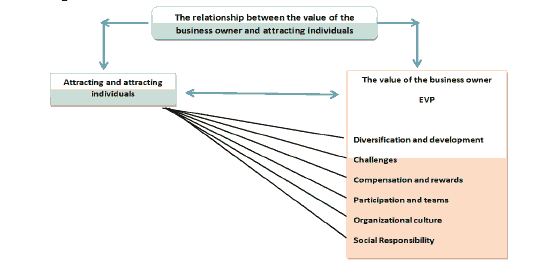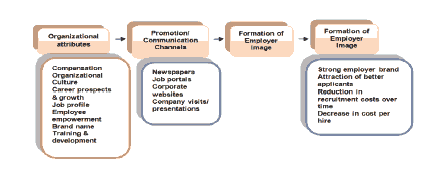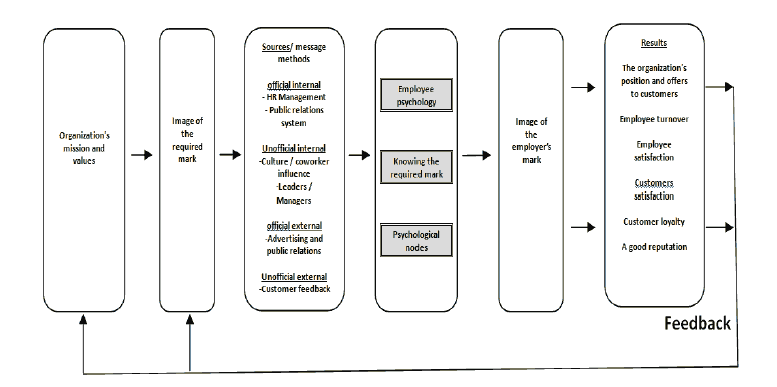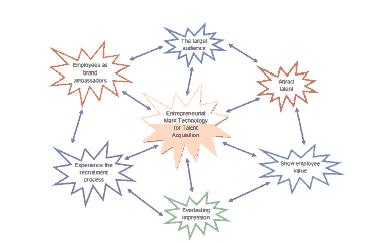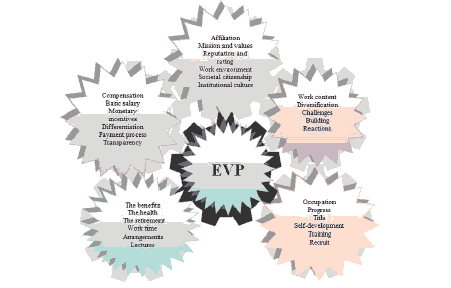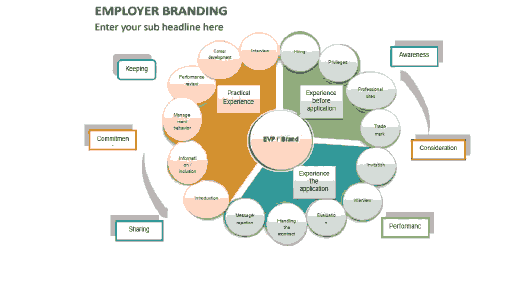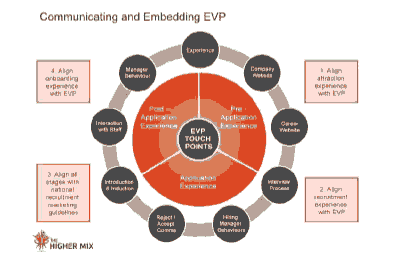Research Article: 2021 Vol: 20 Issue: 4S
The Value of the Employer is an Approach to Attract Individuals. An Analytical Study of the Opinions of External a Sample of Lecturers in the Evening Study in Some Colleges at University of Mosul
Maysoon Abdullah Ahmed, Mosul University-College of Administration and Economics
Marwa Laith Thanoon Al-Abaiji, The Researcher
Keywords:
Employee Value Analysis, Polarization, Scientific Competencies
Abstract
The current research aims to display Employee Value Proposition (EVP) which is the balance of rewards and benefits that employees receive for their performance in the workplace, and organizations generally develop EVP to provide a stable platform for the employer brand and experience management, as the EVP was returned as a magnet that attracts candidates to work. The (EVP) is one of the important topics that would raise the level of organizations as it used a competitive advantage to attract scientific competencies, and in order to obtain a trained and efficient human force capable of applying the new administrative philosophy to attract efficient individuals that were required to colleges after the law that was issued by the Ministry of Higher Education and Scientific Research, to separate the morning study from the evening study, a new philosophy had to be adopted by the evening colleges administration. Therefore, the two researchers sought to choose some colleges that enjoy evening study as a field for the current research, and selected a sample of (43) external lecturers, and from this point the research problem was launched which was formulated from a major question, the value of the employee (the EVP) cannot be relied upon the attracting of scientific competencies?, to achieve this, a fundamental assumption has been made, employee value analysis (the EVP) is a competitive advantage to attract scientific competencies, and in order to collect data, a checklist was relied upon as a main tool to obtain the appropriate information in the field, as it will be analyzed using multiple factor analysis and the research reached several conclusions and in its light, a set of basic proposals has been proposed.
Introduction
One of the main challenges for organizations today in a technology-dependent business environment, which is changing rapidly is to meet the growing demand for a talented and talented workforce, and it is important for educational organizations to search for and attract and recruit suitable candidates, and searching for modern means and methods by taking advantage of the integrated administrative sciences that enable them to attract potential candidates, and by highlighting the unique aspects of job offers for organizations.
The First Topic: Research Methodology
First: The Research Problem
Attracting efficient human resources has become one of the main tasks and functions that fall on the responsibility of human resources management, which requires searching for modern administrative ways and means that need to be used, and given the colleges suffered from the problem of separating the morning study from the evening study with regard to competent teaching staff, from here, the research problem emerged, which was formulated by the two researchers with clear questions as follows:
1. Is the employee value Proposition (EVP) reliable to attract and attract scientific competencies?
2. What is the level of each of the value of the business owner according to its main pillars according to the opinions of the respondents?
3. What is the nature of the correlation between the value of the business owner and the attraction and attraction of individuals?
4. What is the nature of the impact between the value of the business owner and attracting and attracting individuals?
Second: The Research Goal
1. The current research seeks to try to diagnose the value of the employer in the evening colleges according to the opinions of the respondents.
2. Analysis of the nature of the relationship between the value of the business owner and attracting respondents.
3. Measuring the impact of the relationship between the values of the business owner and attracting respondents.
Third: The Importance of Research
The importance of the research stems from the importance of the variables that have been researched and the field of testing in a vital field such as the University of Mosul, as the research derives its importance through the following:
1. The importance of the variables for the researched field, as it is an important administrative method in attracting highly qualified individuals.
2. The importance arises from what is focused on it by finding the main pillars of the value of the employer appropriate to the field being researched.
3. The fact that the research is one of the first studies to the extent that the two researchers at Mosul University deal with a fundamental problem as shows in Figure 1.
Fourth: Research Sample
Five: Research Hypotheses
According to the hypothetical research model that determines the nature of logical relationships between search variables in order to answer the research questions raised in the research problem, the following main assumptions were formulated:
1. There is a significant correlation between the value of the employer and the attraction and attraction of the individuals surveyed at the macro level.
2. There is a significant effect between the value of the business owner and attracting and attracting the respondents at the macro and micro levels.
Six: Research Community and Sample
The research community consisted of some evening colleges at the University of Mosul represented by (College of Education, College of Law, College of Administration and Economics, College of Arts), while the sample was represented by a number of external lecturers who were contracted after separating the morning study from the evening study, a random sample was chosen from them, as the two researchers distributed (65) forms, (8) were excluded, as they were not valid for analysis (14) were not retrieved, and were analyzed (43).
Seven: Research Methodology
The two researchers relied on the descriptive analytical approach, as it is suitable for analysis.
Eight: Statistical Analysis Tools
Relying on a set of statistical tools available within the SPSS program, represented by the correlation coefficient (Pearson) for the purposes of measuring the strength of the relationship between the variables, and the simple regression coefficient for the purposes of measuring the impact strength between the variables, as well as using the (F) test to determine the impact relationship between the variables.
The Second Topic - Theoretical Framework
First: The Concept of Employee Value Proposition (EVP)
The Employee Value Proposition (EVP) is one of the terms that attracted the attention of researchers is usually used to describe the characteristics of work in the organization, and describes the EVP as a combination of characteristics and benefits and methods of work in it and it is a transaction that can be concluded between the organization and the employee in return for its contribution and performance. This "Individuals Show" distinguishes this employer from its competitor. It answers the employee's questions: "What's that about me?" and "What more”? Can you do more?
Employee value analysis often correlates business outcomes. In the preliminary results of an experimental study of linkage research, Heger Brian discovered that employee value analysis was suggested to be specific to employee engagement and retention, both of which have an impact on business outcomes (Heger Brian, 2007: 121).
EVP analysis indicates a balance between employee job satisfaction and employee performance in a work culture, an employee value proposition can be used as an effective hiring tool as it determines the desired and desired requirements for employees related to work. By creating the best recruitment goals, identifying work needs, locating employees in the right place, and creating values for current employees in the organization (International Journal of Scientific and Research Publications, 2015: 1195).
The employee value proposition (EVP) as a set of offers that an institution provides in exchange for the skills, capabilities and experiences that an employee brings to the organization. The approach is in line with current and integrated workforce planning strategies. (Formally, Minchington: 2005).
It strengthens the link between the employee and the EVP organization and urges all organizations to demonstrate why the work experience in the organization is superior to other organizations, it must determine the value proposition in the policies, operations and programs that show the organization's commitment to employee growth, the development of administrative work, continuous career excellence, and community service...etc. (Tandehil: 2006)
An employee value proposition is defined as a set of features that the labor market and employees perceive as the value they acquire through recruitment to the organization (Corporate Leadership Council Research, 2006). Employee value proposition (EVP) is a balance between rewards and benefits, work policies and practices that employees earn in exchange for their work: that is, it is the reason for the outstanding performance in the organization that distinguishes it from other organizations, and thus may be important in attracting and attracting experienced people (Hill & Tande 2006). As for (EVP) from the stakeholder perspective: "It is a perception that employee value analysis has a major role in participating in creating value for stakeholders" (Pennis &, Adrian: 223). It is defined as giving and obtaining between the company and the worker, and it includes every aspect of the organization’s work and its values, to jobs, culture and colleagues to the rewards program package. (Corporate Leadership Council Research Group, 2012).
From the above we conclude that (EVP) is a case for creating a balance between the talents (skills, capabilities and competencies) that the employee provides to the organization in exchange for (job security, appropriate compensation, and all types of rewards) with a view to attracting and preserving those talents and advancing business organizations.
Second: The Importance of Employee Value Proposition (EVP)
The importance of the EVP's can be determined by the benefits that it achieves for the Corporate Leadership Council, which it has emphasized, as follows: (Corporate Leadership Council Research, 2012)
• Reduced commitment of new appointments by up to 29%.
• Reducing new compensation premiums by up to 50%.
• Increasing the likelihood of promoting the organization by the employees themselves increased 24% to 27%.
• Increased polarization possibility from 24% to 47% on average.
Employees are ready to promote their organization (Dream Employer Research, 2011), as well as its importance appears to organizations by obtaining a greater share in the labor market, and this is important for organizations that want to secure the best talent in an increasingly difficult talent market and this is what was emphasized, as for what indicates its importance for the organizations as a whole, it appears through what was identified by (Barrow & Mosley, 2005).
1. Helps to attract, attract and retain talent.
2. Helps to gain large market share and "difficult-to-hire" talent groups.
3. For organizations operating in a number of countries, EVP helps them define "one size fits all".
4. EVP contains items that appeal to different groups of employees of different assignments, cultures and age groups.
5. EVP is derived from the most successful EVPs from combining the needs of the major sectors of the workforce to form the global brand that is then connected by offering the best for each segment.
6. Helps to rehabilitate the frustrated workforce.
7. The EVP creation process includes surveying and speaking with existing employees. This is very important to know their needs and desires.
8. A participatory tool in itself, and usually enjoyed by workers in practical experience can also help to rebuild and enhance confidence and increase motivation.
9. It helps to set the priorities of the organization's human resources department.
Just as analyzing the value of the creative employee has the ability to attract, employ, retain and satisfy employees as an aspect of the organization’s mental standing, to establish a desired job for competencies.
• A Well-Designed Employee Value Proposition: Increases the access of qualified candidates to the position in the talent pool.
• Re-Workforce: This broadens the aspect of employee confidence and commitment in the organization by creating employee presence by exchanging views and ideas.
• Making the Voice of the Organization Desirable Candidates: A good value analysis of the organization must fulfill all the needs and desires of all employees, and this is a way to attract (attract) employees.
• Best Employment Objectives: An employee's value analysis focuses on how this effectively influences the recruitment process in relation to existing and potential new appointments. The best job offers will definitely express employee attractiveness to a career. Employee value proposition strategies will help us build organizations' reputation, integrity and competitive advantage, in the eyes of employees.
Thus, the use of EVP as a competitive advantage for the organization among similar organizations in the labor market, as well as will definitely serve the purpose of attracting talent and retaining the best talent to improve the growth of the organization and build its reputation.
Three: Pillars of EVP: The presence of seven or more pillars in the EVP that differ from one organization to another according to the business sector, and often occur when major stakeholders require the inclusion of a number of those important pillars of the organization, a motto to attract talent, and a good example of this is “occupational safety” in engineering companies, safety is extremely important to these companies and is considered a value in them, but it is unlikely that one of the main reasons for the skill of an engineer to join this work is likely to be differentiation The main among competitors, along with salaries and corporate social responsibility for the companies.
In Brazil, for example, multinationals and the construction industry are able to distinguish from local companies based on their safety record, and as can be identified topics may be one of these pillars of the EVP (innovation, high culture, performance development and progress). For example, the issue could be that many employees feel that innovation interferes with high performance or that development should not be linked to progress, but innovation and development are real reasons for progress and development (Matthias, 2017). Achieving the right balance is difficult while satisfying all parties (senior leaders, current employees, and potential employees), but it creates a unique (organized) case and distinct position that distinguishes it in the labor market and it makes employees proud to work in it and just as it makes potential employees aspire to work in it and according to (Tandehill Human Capital Consulting) some questions and through answering them we devise other pillars of the EVP:
1. What is the impact of the organization's non-traditional rewards? For example (Nucor Company 2000) provides scholarships for university studies per year for the children of an employee with more than two years of service, the Levi Strauss Foundation also donates $ 500 to local community organizations, and McDonald's offers a three-month leave after 10 years of service.
2. How are we best at our management? For example, Boeing has "no messaging" policies. Team members should solve problems immediately and they are not encouraged to find a manager to solve them.
3. What makes our culture special? For example, (Starbucks) creates an inclusive culture by providing part-time employees with full benefits and stock options, to be the first California Federal Bank to have an informal compensation culture.
After determining all of the above, the company will discuss the role that compensation plays in analyzing the value of the work. The wage must be present and provide employees with a fair return on investing time, skills and energy, according to (Jeffrey Pfeiffer, 1998) Professor of Organizational Behavior at Harvard University, "People work for money, but they do more to actually get the meaning of their lives. They work for fun. And companies that ignore this fact will pay the price for worker loyalty."
From the above, there are six pillars of the EVP (occupational safety, innovation, high culture, employee performance development, material and non-material rewards, decentralization in resolving urgent problems to which the facility is exposed) These and other pillars will be adopted in our study to measure EVP in evening colleges.
Four: The Good EVP Attributes: To ensure that the EVP maximizes returns, it must be built on the attributes that attract and retain talent. It must be consistent with the organization's strategic goals, clearly the EVP should be real, and give employees a sense that the organization is responding to the changes they want to see (Talentsmoothie, 2017: 32), and there are three tests that must be applied and very useful in identifying the pillars of EVP and for each corner you should ask (Matthias, 2017: 49-50).
1. Is this convincing to our target audience? Is it a key point and attracts the kind of people we really need? Again, think again about polarization processes, and anything that is part of the polarization process, such as salaries or corporate social responsibility for the companies...etc.
2. Do we stand out from our competitors? When it comes to EVP substrates, you'll need to show evidence to support those substrates such as Gogol and Airbus, both of which demonstrate cutting edge technology in very different ways, it is possible that all substrates are somewhat similar in another business not in your field. We can develop these pillars (using freedom of innovation) and apply them to two separate companies: Google and Airbus. But the nature of the industry will be what distinguishes them.
3. Is it reliable? Which corner of the pillars is chosen? The need to assess credibility. In fact, it can be said that the EVP is intended for this purpose, no EVP corner should not be credible, and when determining the final set of pillars, so we must not only be keen on the current situation, but who we think about the future.
Five: Employer Mark Operations: The Employer Value Model can be built through a set of processes in the form of sequential steps and as shown in Figure 2.
Figure 2: Steps to Build an Employer Value Model
Source: Chhabra & Sanjeev Sharma (2016), Employer branding: strategy for improving employer attractiveness, the current issue and full text archive of this journal is available at < a herf="www.emeraldinsight.com/1934-8835.htm"www.emeraldinsight.com/1934-8835.htmThe above model shows the value of the business owner’s mark and analyzes the organizations values, ideologies, and policies, by converting a set of organizational values and features into valuable offers that are communicated to potential employees, and communication at this stage is important regardless of whether the organization is the best place to work, because without it you will not be able to generate a willingness to advance from a talented workforce, and that full knowledge about the value propositions of the organization will lead to the formation of the image of the employer mark in insulting potential employees, which will make the work of organizations attractive (Chhabra & Sharma, 2016, P: 58). There are other processes that contribute to building the value of the employer mark presented by (Bali & Dixil, 2016: 185-186), which can be illustrated as in Figure 2 , as shows in Figure 3.
Figure 3: Employer Value Building Processes as per Bali & Dixil Vision
(Source: Bali & Dixit (2016). Employer brand building for effective talent management. International Journal of Applied Sciences and Management, ISSN 2413-, Vol. 2, No. 1, 183-191, 2016).
Six: Employer Value Models: There are many forms submitted by researchers, perhaps the most prominent of which is models.
1. The Employer’s Mark for Talent Acquisition and Retention: That researchers came up with (Venkatesh & Geetha, 2015: 5-6), which includes EVP development mechanisms that must be distinctive and persuasive in order to attract, share, and retain talent, whenever there is a match between EVP for the organization and the employee's values and beliefs, there was a win-win situation, the EVP proposal must discover distinct employee policies and programs that demonstrate the organization's commitment to employee growth and development and must be connected to all possible means of communication channels, and Figure 4 illustrates this example.
2. The Value of the Employer Mark According to the Vision (Browne, 2012): The model represents a structural framework that organizations need in understanding and designing their value proposition and the preferences of their employees and the reasons for any gaps between the aspirations of the employee or organization and the actual EVP to build a full compensation strategy that translates into the employer mark For employees according to this model, priority will be given to financial and non-financial rewards and according to the needs and preferences of the main talent sectors in the organization. The business value framework consists of five main elements: as shows in Figure 5.
• Affiliation: The employee's sense of affiliation with his organization.
• Work Content: Employee satisfaction with their work.
• Career Path: The long-term opportunities that an employee enjoys to develop himself.
• Payment or Compensation: The money that employees obtain for their work and performance.
• Benefits: Indirect compensation including retirement and leave.
3. The Third Model for Sketchbubble, 2019: The model demonstrates the value of the business owner’s mark and distinguishes it from the rest of the models through the adoption of important steps in determining the value of the business mark and these steps on the experience before application and experience of application and experience of application and then the commitment of employees to rely on many elements, including consideration Awareness, Retention, Enrichment, Participation, and Performance in an Organization to Achieve Its Goals (Sjoerd, 2019: 98) as shows in Figure 6.
4. The Fourth Model for Sketch Bubble, 2019: The model represents the value of the employer’s mark and its communications with employees through studying the application of experiences and experience of applying these experiences and its dependence on several variables, including understanding employee behavior and clarifying the vision and mission of the organization and the process of interviewing new employees, and activating the organization's sites to communicate and announce job grades to attract potential employees, this leads to achieving the goals of the organization as shows in Figure 7.
Figure 7: Sketchbubble , 2019 Template
*Source: brand-employer-powerful-https://www.slideshare.net/99880599/creating
Sixth: The Concept of Polarization
The job of selecting and appointing individuals comes directly after the job of polarization, while the latter aims to identify the sources of human resource needs or as a group of activities that seek to attract qualified individuals to work in the organization to satisfy the wishes of both parties while the function of selection and appointment aims to differentiate between individuals applying for vacancies and use. The most appropriate of them, and is intended as polarization, as it is these different stages or processes to search for suitable candidates to fill vacancies in the organization, whether they are internal or external sources (Al-Zibari, 2018: 69).
Before filling jobs with qualified individuals, it is necessary to search for these qualified persons, inform them of the job opportunities available in government agencies, and encourage them to join them. Thus, the art of career recruitment is concerned with the systematic search for qualified individuals who have certain skills, and encouraging them to apply to work in organizations, with appropriate and timely numbers to select the most appropriate among them, in response to the functional needs of the organization (Rashid, 2009: 459), as well as it is a process of identifying Prospective Human Resources and Attracting them (Noe, et al., 2008: 202)
Polarization refers to the different stages or processes to search for suitable candidates to fill vacancies in the organization. As for (Barnouti, 2007: 213), polarization is defined as attracting individuals with the appropriate number, time and qualifications, and encouraging them to seek appointment to the organization.
Polarization is a set of activities and procedures for searching and attracting candidates to fill the job gap with the required number and quality, in the right place and time for the organization (Hammoud & Khersha, 2007: 91). He explained (Maher, 2006: 141)
Polarization defined that after the completion of the strategic planning process for human resources, human resources management begins with a basic task to develop its plans on the ground, this task is to attract the required competencies according to the descriptions and requirements of every job currently available or that can be predicted in the future, the process of attracting and attracting competent human resources, whether from inside or outside the organization, depends on the human resources management strategy (Henkeus & Remery, 2005: 422), in addition to that effective recruitment requires knowing where and how to get the job candidates, as it is difficult to generalize about the best source to all jobs (Roberts, et al., 2001: 8).
Seven: The Importance of Attraction (Polarization): There are a set of points that show the importance of attraction, which was emphasized by many researchers, perhaps the most prominent of which he identified, including the following: (Al-Muhammadi, 2019: 219)
• Good polarization (attraction) opens the door for the organization to provide a sufficient pool of suitable applicants to fill positions at the lowest possible cost.
• Polarization (attraction) contributes to increasing the effectiveness of the selection by attracting suitable individuals, the final choice of which is to reduce the unqualified applicants.
• Polarization contributes to identifying the best means to search for the organization's human resource requirements, whether internal or external, in addition to determining the appropriate means for each type of administrative, technical, or professional specialization.
• Contribute to increasing the stability of human resources in the organization by attracting and retaining qualified and good candidates.
• Polarization is the first step in building an effective and productive workforce.
• Polarization contributes to reducing the efforts and expenditures of human resources activities that inflict the selection process, such as training, by polarizing a suitable, distinguished, and suitable and qualified group of applicants to fill jobs.
• The organization is interested, through the stages and processes of polarization, to communicate its message to the applicants that it is the appropriate place for them to work and build a better career path.
• Achieve the social, legal, and moral responsibility of human resources management by committing to the right research processes and securing the rights of applicants for positions.
The importance of polarization is high in determining the target labor market. The poor choice of the labor market carries the organization high financial costs, costs of time and loss of opportunities (Mathis & Jackson, 2003: 208), the polarization process also focuses on creating inputs for the selection process, so it is assumed that this process aims to achieve a fit between job characteristics and the qualifications of occupants of these jobs (Dessler, 2005: 3).
Eight: The Sources of Polarization: The sources of polarization were classified into two sources: (Al-Zibari, 2018: 69; Al-Hariri, 2017: 94).
1- Polarization from the Inside, which Includes:
• Promotion from the inside, by which we mean the promotion of one of the employees to the vacant position, which usually exceeds the job held by the individual, or the transfer of workers from one department to another within the organization, and some organizations prefer to fill their vacancies from the inside to reduce costs and the availability of information on the performance of their employees and this is done through an internal announcement.
• Announcement: Announcement of vacancies within the organization through the bulletin board in the presence of vacancies with specification of job requirements and qualifications of the applicant.
2- Polarization from Abroad: It focuses on occupying primitive jobs at the first job level, and polarization is carried out from abroad by relying on many sources, including: universities and institutes, labor unions, specialized and craft associations, employment offices, and the media
The Sources of Polarization can be Classified in Different Ways, the Most Important of which are: (Henkens & Remery, 2005: 423-426)
1. Negative Polarization: This is the method or method by which the applicant waits until he is contacted by the organization.
2. Active Polarization: in which the organization searches for suitable candidates through external sources of polarization, such as searching for databases in the internet.
3. Official Polarization: This type is accomplished by publishing the job posting in a newspaper or magazine or using an intermediary between the organization and the potential worker.
4. Informal Polarization: Through the organization's use of the communication network, such as contacting employers in neighboring organizations (Richardson, 2000: 12).
The Factors that Influence Polarization Success can be Identified by: (Thomas, 2006: 56)
A. The use of modern technology that facilitated communication between the two parties to polarization, and reduced its costs, as the Internet became an ideal source for polarization (Al-Qarawi, 2009: 2)
B. Diversity in human resources through the pumping of new blood and ideas into the labor market, and demographic variables in the distribution of human resources (Kratzer, 2006: 3).
C. The timing of the polarization, which must be limited to a specific time period, after knowing the employment and forecasting needs, and after defining the required personnel (Mannet, 2006: 7).
D. The lawfulness of polarization, which is a means of recruitment and employment, and therefore it is necessary that the decision to polarize take into account all aspects, and the relevant legal elements (Dessler, 2004: 15).
E. Holding on and retain competent, polarized individuals to benefit from their abilities and talents after the decision to hire them (Richardson, 2000: 2).
F. The organization should review the inputs to the polarization process and make an appropriate decision about costly and unsuccessful variables.
The Third Topic - The Field Framework
First: Hypothesis Testing
1. The Correlation between the Value of the Business Owner and Attracting and Attracting Individuals at the Aggregate Level of the Variables Discussed:
The content of this hypothesis represents the validation of the hypothesis which states (there is a significant correlation between the value of the business owner and the attraction and attraction of the respondents at the macro level), Table 1 data indicates a positive correlation between the value of the business owner and the attraction and polarization of individuals at the aggregate level, and with a correlation coefficient of value (0.898) at the level of significance (0.05), and this indicates the validity and acceptance of the first major hypothesis of the existence of a correlation relationship.
| Table 1 Engagement Relationships at the Macro Level |
||
|---|---|---|
| Responder variable | Explanatory variable | Attracting and polarizing individuals |
| The value of the business owner | 0.898* | |
| At the level of significance (0.05) N=43 | ||
2. Analyzing the Impact between the Value of the Business Owner and Attracting and Attracting Individuals at the Macro and Micro Levels
The results of the regression analysis shown in Table (2) indicate a positive and positive effect of the value of the business owner combined in attracting and attracting individuals, as the calculated value of (F) was (34.5) which is greater than its tabular value of (4.71), at a significant level (0.05), as for the coefficient of determination (R2) it reached (0.541), and by following (B) coefficients and (T) testing it showed that the calculated value is greater than the tabular (1.998), at a significant level (0.05), accordingly, the second hypothesis is accepted, which states (there is a significant effect between the value of the business owner and the attraction and attraction of the respondents at the macro level), as for the effect relationships on the micro level for each dimension (pillars) of the value of employers in attracting and attracting individuals, we find that Table (2) illustrates the effect of each dimension of the value of the business owner, which shows the existence of a moral effect according to the calculated value (f) data that appears greater than the tabular value at the partial level (15.09) greater than (2.885), as for the influence relationships, we find that compensation takes the largest impact relationship by attracting and attracting the least impact relationship between organizational culture and attracting and attracting individuals at a moral level (0.05 (thus accepting the hypothesis that there is a significant effect between the value of the business owner and attracting and attracting the respondents at the micro level).
| Table 2 Results of the Effect of the Value of the Business Owner and Attracting Individuals |
|||||||||
|---|---|---|---|---|---|---|---|---|---|
| The Independent approved | Value of the business owner | ||||||||
| Compensation | Work teams | Social Responsibility | Organizational Structure | Development | Challenges | R2 | F | ||
| B0 | B1 | B2 | B3 | B4 | B5 | B6 | Calculated | ||
| Attracting and polarizing |
2.3 46 |
0.597 | 0.481 | 0.53 | 0.412 | 0.241 | 0.201 |
0.5 41 |
15.09 |
| (1.445*) | -1.02 | (1.398*) | -1.21 | -0.418 | -0.4 | ||||
| Overall index | 1.998 | 34.5 | |||||||
| The calculated value (T) N = 43 P=0.05 | |||||||||
The Fourth Topic: Conclusions and Recommendations
First: Conclusions
1. It became clear through the theoretical framework that the value of the business owner is one of the basics of the work, and that the field is supposed to take its pillars for the sake of attraction and good polarization, so the field needs to adopt the concept of the value of the business owner and benefit from it in its field of business.
2. There is a significant correlation between the value of the business owner and attracting the respondents.
3. There is a significant effect between the values of the business owner at the macro level.
4. There is a significant effect between the value of the business owner and attracting individuals at the micro level, but in varying proportions.
5. Having the highest impact ratio between compensation, and attracting individuals, and the lowest impact rate between the value of the business owner and organizational culture.
Second: Recommendations
1. Calling the field administrations to adopt the philosophy of the value of the business owner intellectually and practically, as the current era requires the use of modern administrative topics that relate to managing the functions of its human resources.
2. The field must respond quickly to developments that occur in the external environment, especially with regard to wages and compensation that are spent in private colleges compared to evening government.
3. Working to spread the culture of cooperation and partnership and the establishment of work teams between departments and the evening staff, as this staff is still at the beginning of the professional career path.
4. Establishing several training programs for spreading the value of the business owner and its main pillars, and involving the departments responsible for attracting and attracting individuals to do so.
5. Paying attention to evening cadres and striving to satisfy their basic needs and desires, with the aim of creating a sense of social responsibility by departments towards those cadres (the external lecturer).
References
- Thomas., & Struck, S. (2006). Formulating a proposed strategy to attract and maintain scientific competencies - Case study in the education institute. Master Thesis (Unpublished), College of Administration and Economics, University of Baghdad, Iraq.
- Al-Qarawi., & Rania, (2009). A feminist rejection of electronic recruitment websites. Al-Iktissad-e-newspaper, 5788.
- Bernouti., & Naef, S. (2007). Human resources management (Personnel Management), (third edition). Wael Publishing and Distribution, Amman, Jordan.
- Al-Hariri., & Rafidah, (2017). Modern trends in human resources management, (first edition). Dar Al-Yazouri Scientific Publishing and Distribution, Amman, Jordan.
- Kazem, H.K., & Al-Kharsha, K.Y. (2007). Human resources management, (first edition). Dar Al-Masirah for Publishing and Distribution, Amman, Jordan.
- Rashid., & Fares, M. (2009). Human resources management, (third edition). Obeikan Publishing, Saudi Arabia.
- Al-Zibari., & Khanu, J. (2018). Human resources management Jobs, a theoretical framework and practical cases, (first edition). Dar Al-Manhahej for Printing and Distribution, Amman, Jordan.
- Ahmed, M. (2006). Human resources management. University House, Alexandria, Egypt.
- Al-Muhammadi., & Rehan, S.A. (2019). Human resources management - An integrated strategic and methodological vision, (First Edition). Al-Yazouri Scientific Publishing and Distribution House, Amman, Jordan.
- Brian, K.H., (2007). “Linking the employees value proposition to employee’ engagement and business outcomes: Preliminary findings from a linkage research pilot study”. Organization Development Journal, 25.
- Frow, P., & Payne, A. (n.d). “A stakeholder perspective of the employee value proposition concept”. European Journal of Marketing, 45.
- Kene, H., & Chantal, R. (2005). Recruiting personnel in a tight labour market: An analysis of embloyers behavior, International Journal of Manpower, 26(5).
- Mathis, R.L., & Jakson, J.H., (2003). Human resource management. Thomson South–Western, USA. 10
- Zeuch, M. (2017). Handbook of human resources management. Springer Nature, Murten,
- Gary, D. (2004). Human resource management. Pearson Education, Canada.
- Andrew, R.N., Bech, H., John, R., Barry, G., & Patrick, M.W. (2008). Human resources management, (9th edition). Mac grow hill companies, New york, USA.
- Gary, R., Gary, S., & Garlotta, R. (2001). Human resource management.
- Gary, D. (2005). Human resource management.
- Nick, K. (2006). Employment Policy.
- Mannet, S. (2006). Lever three–staffing strategy framework.
- Richardson, M.A. (2000). Recruitment strategies, Article which introduces the original concept, by tande hill human capital. Work span.
- Corporate Leadership Council Research. (2006). Employment value proposition survey.
- Corporate Leadership Council Research. (2012). Employment value proposition survey.
- Hill, B., & Tande, C. (2006). Total Rewards: The employee value proposition, work span. February 19 (2014).
- Barrow, S., & Mosley R. (2005). The employer brand: Bringing the best of brand management to people at work. John Wiley & Sons 021814.
